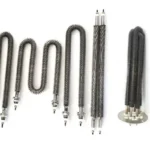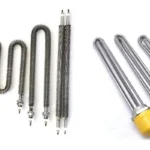Are you looking for an efficient and reliable heating solution for your industrial processes? Flange heaters might be the perfect answer.
A flange heater is an industrial immersion heater installed directly into a tank or vessel wall through a flanged opening. It is used to heat liquids, gases, and other substances in tanks and pressure vessels.
Let’s dive into the world of flange heaters. We’ll explore their applications, types, and key benefits. This will help you understand if they’re the right choice for your heating needs.
What is a Flange Heater? Applications, Types, and Key Benefits?
Imagine needing to heat a large tank of oil quickly and evenly. Flange heaters make it possible.
Flange heaters are industrial heaters that are mounted through a flanged opening in a tank or vessel. They are used for heating various substances like water, oil, and chemicals in large tanks.
Dive Deeper
Flange heaters are versatile and used across many industries. To better understand their applications, types, and benefits, let’s break it down:
| Feature | Description |
|---|---|
| Applications | Heating liquids in tanks, oil and gas industry (heating crude oil), chemical processing (maintaining reaction temperatures), food and beverage industry (sterilization), water heating (large volume water heating) |
| Types | Screw plug heaters (for smaller tanks), circulation heaters (for continuous heating), immersion heaters (direct heating in tanks) |
| Key Benefits | Efficient heating, easy to install and maintain, precise temperature control, customizable for different applications, durable and long-lasting |
I remember one of our clients, a large chemical processing plant, was struggling with inconsistent heating in their reactors. They switched to our flange heaters. The result was a significant improvement in temperature control and product quality. They also reduced their energy consumption. It was a win-win situation! Flange heaters can make a huge difference in industrial settings.
How to Choose the Right Flanged Immersion Heater for Industrial Use?
Choosing the right flange heater can seem complicated. But it’s important to get it right.
To choose the right flange heater, consider the fluid type, temperature requirements, tank size, and material compatibility. Proper selection ensures efficient heating and prevents corrosion or damage.
Dive Deeper
Choosing the correct flange heater involves several factors. Let’s look at the key considerations. I will provide you with a structured approach to make the right decision:
| Factor | Description |
|---|---|
| Fluid Type | Different fluids require different materials. For example, corrosive fluids need stainless steel or titanium heaters. Oil needs heaters designed to prevent coking. |
| Temperature Requirements | Know the required operating temperature. This helps determine the heater’s wattage and material. Higher temperatures often need high-wattage heaters and high-temperature alloys. |
| Tank Size & Dimensions | Tank size affects the heater’s size and number of heaters needed. Larger tanks may need multiple heaters. The physical dimensions of the tank also impact the heater’s design and placement. |
| Material Compatibility | The heater’s material must be compatible with the fluid. Incompatible materials can lead to corrosion, contamination, and heater failure. Always check the compatibility chart or consult with a material expert. |
| Watt Density | Watt density is the amount of power per unit area on the heater’s surface. High watt density can cause fluid degradation or heater burnout. Select an appropriate watt density based on the fluid and its flow rate. |
| Control Systems | Decide on the type of control system needed. Options include thermostats, temperature controllers, and PLCs. The control system helps maintain the desired temperature and protects the heater from overheating. |
We once had a client who ignored material compatibility. They used a standard stainless steel heater in a tank containing a highly corrosive acid. The heater failed within weeks. After replacing it with a titanium heater, they had no further issues. This shows how crucial it is to consider all factors.
Top 5 Manufacturers of Flange Heaters: A Buyer’s Comparison Guide
Finding a reliable manufacturer is key to getting a quality flange heater. But who are the top players?
While specific rankings can vary, reputable flange heater manufacturers are often known for their customization options, quality materials, and industry experience. Researching customer reviews and comparing product specifications is important.
Dive Deeper
The market offers many flange heater manufacturers. Each has its own strengths. To help you choose, here’s a comparison guide based on general reputation and product offerings:
| Manufacturer | Strengths | Considerations |
|---|---|---|
| ELEKHEAT (That’s Us!) | Customization, wide product range, fast lead times, excellent customer support. We focus on energy efficiency and durability. | We may not be the cheapest option, but we offer superior value. |
| Company A | Broad product portfolio, global presence, established brand. | Can be less flexible with custom orders, longer lead times. |
| Company B | Specializes in high-temperature applications, advanced materials, and custom engineering. | Higher prices, may not be ideal for standard applications. |
| Company C | Cost-effective solutions, good for standard applications, quick delivery. | Limited customization options, may not be suitable for demanding environments. |
| Company D | Focuses on energy-efficient designs, offers innovative heating solutions, and has a strong R&D department. | Can be more expensive than other options, may require longer evaluation periods. |
I remember a potential customer who was torn between us and a competitor. They needed a highly customized flange heater for a unique application. After discussing their specific needs and demonstrating our customization capabilities, they chose ELEKHEAT. They were impressed with our ability to deliver a solution that perfectly matched their requirements.
Maintenance Tips for Maximizing the Lifespan of Your Flange Immersion Heater
Proper maintenance is essential for extending the life of your flange heater. Neglecting maintenance can lead to costly repairs or replacements.
Regularly inspect your flange heater for signs of corrosion, scale buildup, or damage. Clean the heater elements, check electrical connections, and ensure proper temperature control to maximize its lifespan.
Dive Deeper
To ensure your flange heaters operate efficiently and last long, follow these maintenance tips. It’s about proactive care:
| Maintenance Task | Description | Frequency |
|---|---|---|
| Regular Inspections | Check for signs of corrosion, scale buildup, leaks, or physical damage. Look at the flange connections, heating elements, and wiring. Early detection can prevent major problems. | Monthly |
| Cleaning Heater Elements | Remove scale, sediment, or other deposits from the heating elements. Use a soft brush or appropriate cleaning solution. Buildup can reduce heating efficiency and cause overheating. | 3-6 Months |
| Checking Electrical Connections | Ensure all electrical connections are tight and free of corrosion. Loose connections can cause overheating and electrical hazards. Use a multimeter to check voltage and current. | 6 Months |
| Calibrating Temperature Controls | Verify that the temperature controls are accurate. Use a calibrated thermometer to check the actual temperature against the setpoint. Adjust or replace the controls as needed. | Annually |
| Testing Safety Devices | Test safety devices like over-temperature cutoffs and pressure relief valves. Make sure they are functioning correctly. Faulty safety devices can lead to dangerous situations. | Annually |
| Documenting Maintenance | Keep a record of all inspections, cleaning, and repairs. This helps track the heater’s performance and identify potential issues. Documentation is valuable for warranty claims and future maintenance planning. | Every Task Performed |
I once visited a plant where they had completely ignored heater maintenance. Their heaters were caked in scale and corrosion. The heaters were operating at reduced efficiency and failing frequently. After implementing a regular maintenance schedule, they saw a significant improvement in heater performance and lifespan.
Flange Heaters 101: Installation Best Practices and Common Use Cases
Correct installation is as important as choosing the right flange heater. Poor installation can lead to safety issues and heater failure.
Proper flange heater installation involves ensuring a secure flange connection, correct wiring, and adequate clearance. Common use cases include heating water, oil, and chemicals in tanks across various industries.
Dive Deeper
Proper installation ensures optimal performance and safety. Let’s cover some best practices and common use cases:
| Aspect | Best Practices | Common Use Cases |
|---|---|---|
| Flange Connection | Ensure the flange is properly aligned and securely bolted to the tank. Use a gasket that is compatible with the fluid. Torque the bolts to the manufacturer’s specifications. A secure connection prevents leaks and ensures proper heat transfer. | Heating water in large storage tanks for industrial processes, providing hot water for cleaning and sanitation. |
| Wiring | Follow all electrical codes and guidelines. Use the correct wire size and type. Ensure the wiring is properly grounded and protected from moisture. Incorrect wiring can cause electrical hazards and damage the heater. | Heating oil in refineries and power plants to reduce viscosity and improve flow, maintaining the temperature of hydraulic oil in machinery. |
| Clearance | Provide adequate clearance around the heater for air circulation and maintenance. Avoid placing the heater too close to the tank walls or other equipment. Proper clearance prevents overheating and allows for easy access. | Heating chemicals in reactors and storage tanks, maintaining reaction temperatures, preventing crystallization, and ensuring proper mixing. |
| Temperature Control | Install a reliable temperature control system. Use a thermostat or temperature controller to maintain the desired temperature. This prevents overheating and saves energy. | Heating process fluids in food and beverage plants, sterilizing equipment, pasteurizing milk, and maintaining the temperature of cooking oils. |
| Safety Devices | Incorporate safety devices such as over-temperature cutoffs and pressure relief valves. These devices protect the heater and the equipment from damage in case of malfunction. | Heating air and gases in HVAC systems, drying processes, and industrial ovens, providing consistent and controlled heat for various applications. |
I once saw a poorly installed flange heater that was causing frequent electrical shorts. The installer had used the wrong wire size and hadn’t properly grounded the system. After correcting the installation, the problems disappeared. This shows the importance of following best practices.
Conclusion
Flange heaters are efficient, versatile, and essential for many industries. By understanding their applications, selection, maintenance, and installation, you can ensure optimal performance and longevity.











